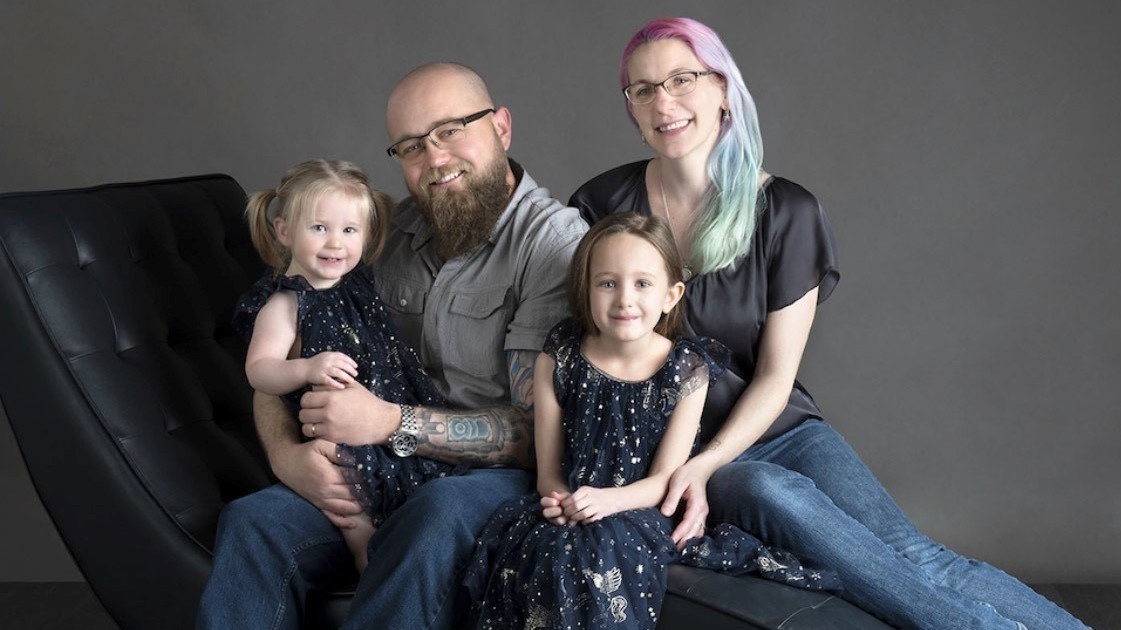We hope to see you again soon!
You are now leaving Lundbeck UK's website (www.lundbeck.com/uk) for an external website. External links are provided as a resource to the viewer. Lundbeck UK are not responsible for the external website and its content.
UK-NOTPR-1010 | April 2022

Jenna Humphries
Living with migraine: a bit of understanding
Meet Jenna Humphries from Australia who has been living with migraine since childhood. This is her touching story about growing up with migraine and finding her purpose in a life marked by pain.
Jenna Humphries
Melbourne, Australia
37 years old
Family
Married to David with two girls aged 8 and 3 years
Occupation
Administration and finance; obtained her Bachelor of Accounting and currently training to become an electrician.
It happened when she was only seven years old, an age that is usually remembered as carefree by most adults in Australia.
“I ended up in the hospital with that one and throwing up all over doctors,” Jenna says, vividly remembering her first severe attack.
Throughout pretty much all of high school, she had to live with migraine. She had to push herself through it and take painkillers almost daily. At the age of 12, she started to take migraine preventatives.
“I just lived life as I could”
While the teenage years are usually exciting and packed with social events, due to her migraine, Jenna had to say no to most social activities - the pain was just too draining.
“Growing up, I’ve always been in constant pain, so for me, there was nothing different. I didn’t go out very often because I was in too much pain, or I was throwing up a lot. I just lived life as I could,” she elaborates.
Despite symptoms ranging from severe headaches to light sensitivity (photophobia) and vomiting every 20 minutes, Jenna experienced a lot of discrimination at school from teachers and friends who did not understand.
“I didn't socialise as much as I wish I could have. I wasn't invited out to a lot of activities with school friends because they knew I would be in pain. I also didn’t get a lot of help from my teachers with extensions on homework or assignments. I was expected to do the work as everyone else did,” she says.
On some days, her eyes were so sore from a migraine attack that she had to wear sunglasses inside. However, her teachers told her to take off the sunglasses and just deal with the bright lights. Sometimes, she would need to leave in the middle of class to go and throw up, but teachers wouldn’t believe her, so a couple of times she threw up in the classroom. Her requests for special consideration and extra help were ignored, however, she managed to finish school.
“I just kept going,” Jenna puts forth.
“This was the attitude of most people while I was growing up: ‘it’s just a headache’. No one believed that you can be so young and get migraine”
Jenna Humphries
“It’s just a headache”
The most debilitating part of living with migraine for Jenna was that she felt that people often did not believe her. At one point, Jenna decided to stop asking for help because she felt there was no point in it.
“This was the attitude of most people while I was growing up: ‘it’s just a headache’. No one believed that you can be so young and get migraine,” Jenna says.
“It’s hard for people to understand what I am going through. No one believes that you can be in so much pain and just still be going about your day because you have to, you don’t have a choice,” she adds. As an adult, Jenna has lost jobs from taking “too many” sick days.
“Especially when I was at work I just had to keep pushing through.”
Although she was suffering from a bad headache, she had to keep pushing through and just turn the brightness of her computer down. At migraine-friendly workplaces, Jenna says, the environment can be adapted when a migraine attack occurs.
“Being able to turn the lights down or have quiet rooms that don’t have quite as much brightness and noise can be incredibly helpful.”
A bit of understanding
Thanks to effective management, Jenna is now able to travel and enjoy playing with her two kids without interruptions. In fact, Jenna only had her second child because she felt well enough to proceed with a pregnancy.
Today, she very rarely experiences severe attacks. Around once a month, she experiences what she calls a small migraine, which is not as bad as it used to be.
With her newfound strength and energy, Jenna has decided to pursue a new career. “I did an accounting degree, which I didn’t find fulfilling in the end. I’ve now found the energy to change jobs, and I’m currently learning to be an electrician. I must be alert and focused all the time. I couldn’t do that before. I couldn’t focus very well for more than half an hour to an hour without needing a break, whereas with this job I must be focused at all times. And I can do that now.”
If there was one thing Jenna could change in society to support people with migraines more, it would be a bit more understanding from others.
“I just want a bit of understanding, almost a bit of leniency. If I don’t want to talk due to a bad headache, people should not be offended by that.”
“This was the attitude of most people while I was growing up: ‘it’s just a headache’. No one believed that you can be so young and get migraine”
More stories from Lundbeck
UK-NOTPR-2612 | August 2025